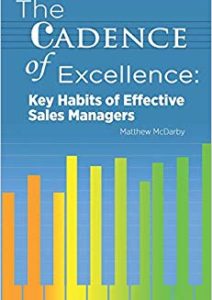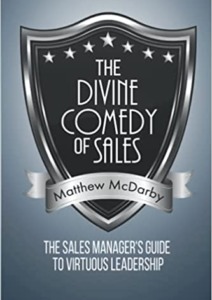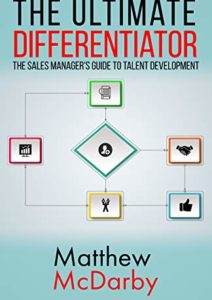Using Social Channels to Align With Your Buyers’ Journey
Editor’s Note: Today we are posting Chapter 4 of a 10-chapter book, authored by our CSO, John Golden and Matt McDarby, President of United Sales Resources.
John and Matt have collaborated before and have joined forces with this book to provide expertise to help our readers — particularly Sales Managers who effectively manage salespeople in a social selling era. While there is currently plenty of information about social selling (including a book by co-author John Golden), there is a clear need for more information about how to manage a social sales team.
Without Sales Managers who believe in the benefits of social selling and know how to help and guide their salespeople to adopt social selling techniques, sales teams will not be successful at social selling.
We’re publishing the entire book in installments. Every three weeks or so we will post a chapter of the book — outlining 10 simple rules to:
- Equip Sales Managers to help their sales teams unlock the power of social selling.
- Show Sales Managers how to align their sales teams with the new and evolving buyer behaviors.
- Enable Sales Managers to create a culture and environment in which social selling is not just accommodated, but embraced.
- Teach Sales Managers how to effectively coach and mentor social selling excellence.
The role of Sales Manager is one of the most important in any organization, and yet they these employees are often the most under-supported, under-trained, under-invested in, and especially — misunderstood. As if that’s not enough, they also usually take a disproportionate amount of blame when sales numbers go south. – John Golden
Thanks to the advent of social media and its impact on buyer behavior, it is more critical than ever for Sales Managers to understand how to effectively lead their salespeople in the emerging era of social selling.
We encourage you to comment, ask questions, and offer your own insights. After all 10 chapters are published on the blog, we will make the book available in our Sales Reference Library as a free download.
*****
Chapter 4: Using Social Channels to Align With Your Buyers’ Journey
Because buyers today use social platforms such as LinkedIn, Twitter, and Facebook to do their homework, often they know more about us sellers than we do about them as buyers.
By way of their social media connections, buyers have real-time, all-the-time access and can identify challenges and opportunities facing their industry. They can contemplate potential solutions to their problems, and read all the news that’s fit to print about potential suppliers.
The pace, flow, and focus of buyers’ decision-making has shifted as a result — changing Sales forever.
The degree to which the buyer researches companies and salespeople is driven in part by what we call the Buyer’s Journey. It is therefore crucial to understand as much as we can about how buyers go about making decisions today — specifically, how buyers might use social media to inform the choices they make.
Who Is This Smart and Powerful Social Buyer Anyway?
A social buyer is anyone (whether a middle manager, C-level executive, business owner or otherwise) who uses social media to inform their purchasing decisions.
Before the birth of social platforms, buyers identified issues or opportunities affecting their businesses in a deliberate way. They went through a protracted phase in which they discovered challenges and steadily moved from their once satisfied state to a state of dissatisfaction.
Today’s social buyers are immersed in a sea of information and are constantly conscious of issues and opportunities affecting their businesses. They are empowered by information available via social platforms to identify and classify them quickly. They expect to re-evaluate and change quickly — because they have access to better, newer, shinier products and services than ever before.
In short, the pace at which a buyer moves from satisfied with the current state to dissatisfied and ready to act has accelerated because of social platforms.
In this model, it can be extremely difficult for sellers to identify the status of a decision making process — which stage they are in — but they must try if they want to have a chance at achieving a positive sales outcome.
What Do Social Buyers Want to Know?
Rather than dive into a blow-by-blow narrative of what each phase of the social buying process looks like, it is more productive to think about the questions a buyer might have as they progress through the journey.
As sales professionals consider the questions that are likely to occupy the buyer, they may discover opportunities to create value and insight for prospects. Common questions that social buyers consider and pose to their social networks include the following:
1) How do we compare to others in our industry?
2) Is there evidence (on the social platforms I use) that others in our industry are dealing with the same issues that we are? Which opportunities are they pursuing?
3) Do we need to take any action now?
4) Have others I’m connected with found a way to cope with the issues we’re experiencing?
5) When did those people reach the point where inaction was no longer an option?
6) What can I do on my own to capitalize on this opportunity?
7) Can I find like-minded businesspeople on LinkedIn or another social network who have dealt with this sort of situation before?
8) If I cannot do this on my own, who out there has the relevant experience to guide me?
9) Can anyone recommend potential suppliers?
10) Can I find proof that those suppliers can deliver the sort of result I need?
11) Once I’ve identified a solution/provider, how will I know if I can trust them?
12) Who has experience working with a specific provider? Does anyone have any success stories? Horror stories?
The point of thinking about these questions is to identify opportunities to create value or insight for a social buyer. If we can mirror their likely journey using social media channels, what are the answers we would find? Where would we look in the social ecosystem? How would we want to engage with salespeople along the journey?
Walking in Your Buyers’ Shoes
Once we’ve considered the ways in which our sellers can create value or insights for buyers, we can think about how sales tactics might need to change. For instance, how could your salespeople change the way they react to buyers’ questions or comments in LinkedIn groups or on Twitter? What would be the best way to respond to a question like this?
“We’re looking for information on solution providers in a certain area…?”
Should your sales rep respond with information about your company’s capabilities, assuming that the buyer is really asking, “Can anyone recommend potential suppliers?” Or should they seek to clarify where the buyer is in their decision making process first?
A graceful way to respond might be to ask this kind of clarifying question:
“Interesting question, Miss Buyer. Are you asking because you are looking for information from potential suppliers, or are you interested in advice from others who have addressed an issue you are experiencing right now?”
Knowing how sellers typically reply to questions from prospective buyers (sell! sell! sell!), it’s likely that your sellers may stand out among the crowd simply by virtue of asking that one thoughtful and clarifying question.
Using a Basic Selling Practice — Clarify and Confirm!
In this scenario, we are applying a known principle of effective selling…clarify and confirm what the buyer wants / needs / would value before you offer information about yourself and your capabilities. The fact that you’re interacting with the prospective customer over social media doesn’t change the value of that important principle. It’s a very useful and appropriate technique when applied to social media interactions.
Let’s look at another common example to test how sales tactics could be changed. A buyer poses a question about a specific supplier on a LinkedIn group. A salesperson from a competitive firm notices the question and can choose from a range of tempting responses, including:
-
“Don’t hire those charlatans, hire us instead.”
-
“We’re an option, too.”
-
No response; ignore.
Which of those would be the most appropriate and effective response?
Put yourself in the buyer’s shoes and determine which response would be most useful.
Clearly, casting aspersions on a competitor is tacky and not professional. The “We’re an option, too,” response might not be all that helpful and potentially viewed as an unwanted advance. The lack of any response might mean that you as a buyer receive no useful information from your network, which would be bad, too.
But what if all the prospect was really trying to find out was proof that there were candidates for their business who could demonstrate that they were worthy and could deliver a good result? What kind of response would catch your attention if you were that potential buyer?
“Mr. Buyer, I noticed that you asked about Supplier X in a LinkedIn group discussion. Are you asking specifically about that Supplier’s capabilities (which I can’t necessarily comment on), or are you asking about ways in which you can guarantee the result you want to achieve? In either case, I will be rooting for you to get the solution you need, and I would be happy to chat and try to help you get that result.”
Wow — will every buyer respond favorably or at all to that question? Perhaps not, but the question is a far less risky way for a seller to respond than to simply take the buyer’s question at face value. Faced with the choice of forcing the buyer to push back on our offer versus trying to clarify and pulling the customer into a discussion, we would choose the latter every time.
Clarify and Confirm: A Few More Practical Tips
Reacting directly to buyers’ posts or tweets is not the only thing a salesperson can do independently to investigate and determine where a buyer might be in their decision making process.
Following are a few, practical ideas for you and your team to consider as you seek to clarify and confirm where a social buyer may be in their decision making process:
-
Check out the customer’s profile on LinkedIn to see what his or her recent updates might indicate. Have they posed questions in LinkedIn group discussions? Have they asked questions or made statements in their news feed that indicate their awareness of or their orientation toward certain business problems or opportunities?
-
On Twitter, have they favorited, retweeted, or published tweets related to problems or opportunities you can address or perhaps specific solutions or competitors?
-
What problems or opportunities might the seller highlight in an InMail message or DM? What clarifying questions can the seller plan to ask (in a brief, appropriate-for-social-media sort of way) to zero in on issues and opportunities of interest to the prospect?
We acknowledge that some buyers may think you or your team presumptuous for digging into their various social profiles at depth to find clues about what is important to them. Some people will not like that. But we wonder what is worse… jumping to conclusions about what a customer values or getting caught doing one’s homework? Remember, you are not doing anything untoward by researching information that’s public and easily available.
We will leave that to you to decide. Above all, we recommend that you and your team pay particular attention to the Buyer’s Journey, and work together to determine how you can go about identifying, aligning with, and attempting to influence the social buyer’s thinking throughout the journey.
Key Points From This Chapter
-
Social buyers today are constantly conscious of issues and opportunities affecting their businesses, and the pace at which a buyer moves from satisfied with the current state to dissatisfied and ready to act has accelerated because of social platforms.
-
Sellers need to understand how buyers are using social media now to inform their choices.
-
Sellers should avoid taking certain common social cues at face value, and they should instead seek to clarify what is behind questions and requests that buyers post on forums such as LinkedIn, Twitter, or Facebook before responding.
-
Sales teams that apply sound selling principles such as the rule of clarifying first before responding will have more success than those that do not. The rules of effective selling apply over social channels just as much they do in the offline world.
Get your free trial of Pipeliner CRM now.













